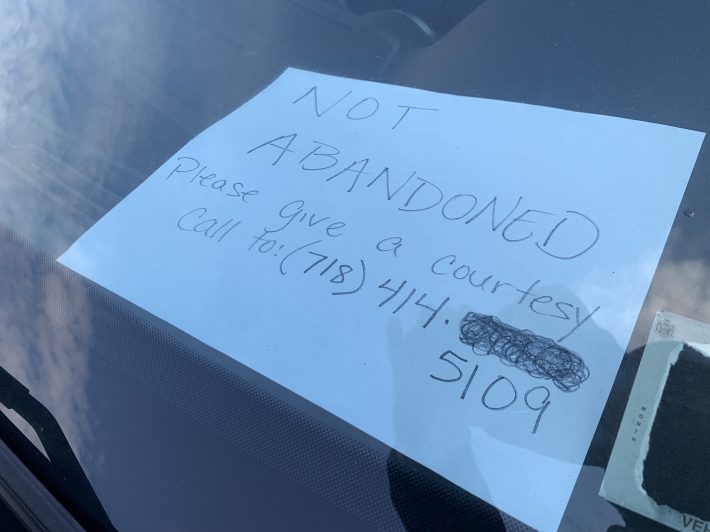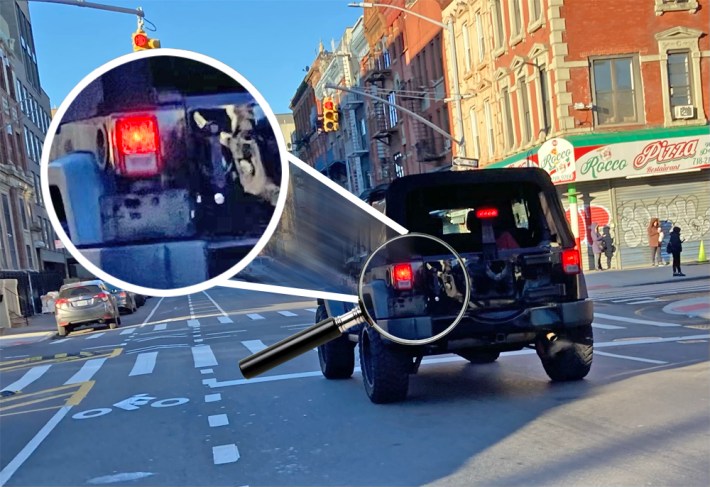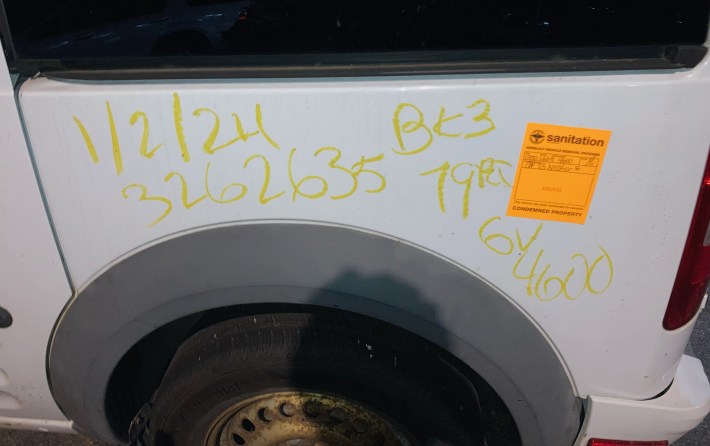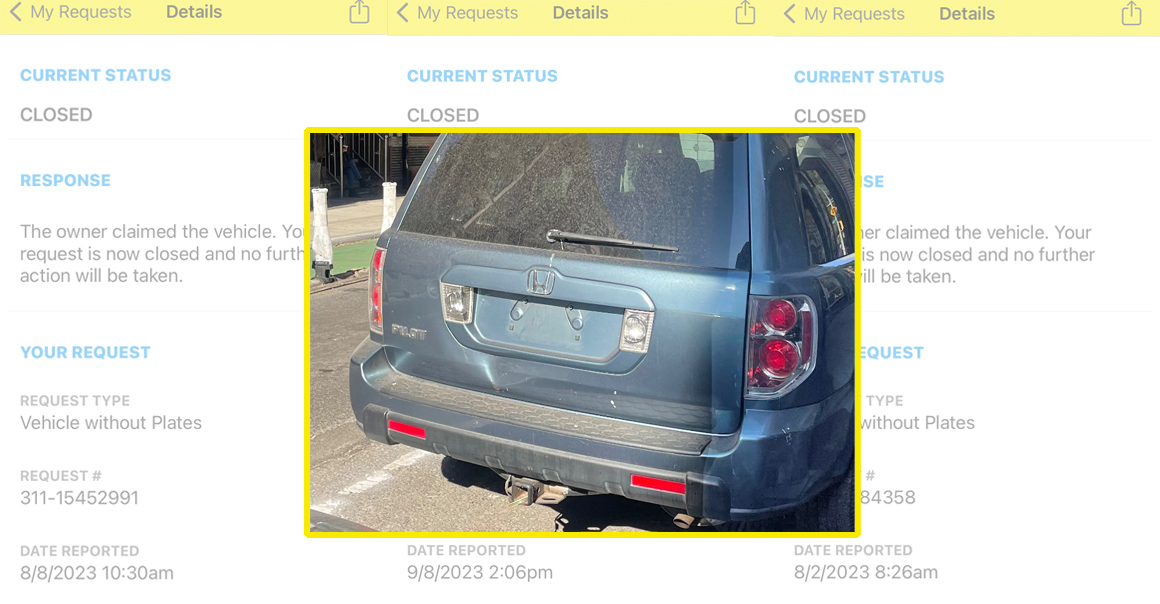Cars without license plates are everywhere in New York City, but the Adams administration has been slow to address the problem, allowing tens of thousands of drivers to skirt accountability on the road each year.
The city received more than 51,000 complaints about cars parked illegally on the street with no license plates in 2023, according to 311 data analyzed by Streetsblog. From those complaints, the Department of Sanitation removed only 1,821 cars, or just 3.5 percent.
The agency said it removed other cars through a new program with the NYPD that is showing promise, but the total number of plateless vehicles removed remains paltry compared to the tens of thousands of complaints:
As the chart above shows, reports to 311 about plateless cars (red line) are up 57 percent since 2020, yet the number of cars removed as a result of those complaints (yellow line) remained pretty much flat. (The total number of towed vehicles is represented by the orange line.)
Officials and street safety advocates say that the shortfall in enforcement allows reckless drivers to dodge responsibility for their vehicles on city streets.
"Cars with ghost plates are a risk to public safety, while abandoned cars can be shelters for rodents and lower the quality of life for people on a block," said Council Member Sandy Nurse (D-Brooklyn), who heads the Sanitation Committee. "These are consistent complaints from residents for all Council members and we need to see more resources dedicated to this work."
What's going on?
A crucial flaw in the battle against plateless cars is that the city often does not tow cars simply for lacking plates, despite the risks of having tens of thousands of them on the road.
The Department of Sanitation only removes cars that it deems "derelict," meaning that they are abandoned junkers — garbage, if you will. Plateless cars that are operable often get referred to the NYPD, which has a poor towing record. As a result, drivers all over town are getting away with parking their $40,000 Range Rovers, Audis and Mustangs without plates.
Streetsblog staffers have reported more than two dozen plateless cars over the past few weeks, and only one was confirmed as towed away. In one fairly typical case, a reporter used 311 to document a plateless Volkswagen — only to get back a notice claiming that "the owner claimed the vehicle" and the city would take no further action, even though the car was in the same spot, still without plates.

After another report to 311, the Volkswagen owner did put plates on it — and, in doing so, revealed why many drivers perpetuate this scam. According to city data, the car has racked up 69 parking and moving violations since mid-2018. More notably, the car was nabbed by cameras 31 times for speeding or running red lights between April 2019 and August 2022, roughly once a month. In the 16 months since, the car has not been caught on camera at all — suggesting that this repeatedly reckless driver is avoiding accountability by keeping his plates off the vehicle.
That silver VW above was one of 15 plateless cars that Streetsblog found during a recent one-hour bike ride through Bedford-Stuyvesant, a neighborhood that has emerged from the pandemic as an epicenter of plateless vehicles.
Those plateless cars included: a gorgeous orange Caddy from the 1970s with a fake Chaplain placard, four cars on a single block of Marion Street, an Infiniti with an FDNY placard on the dash, and a sporty Mustang with a sign reading "Car won't start" (which more or less admitted that the car inoperable):
Most drivers had removed the registration sticker or had covered up the vehicle identification number as well, which makes it impossible to ticket these vehicles.
Of the 15 plateless cars that Streetsblog reported to 311, the city removed only one.
The Sanitation justified letting 14 others remain on the street by saying that vehicle owners "claimed" five of them, that six were too valuable to be towed, that two did have license plates, and that one could not be found.
But Streetsblog found 10 of the 14 cars a few days later — all still parked in or near the same place, all without license plates.
One car — a Range-Rover — had the registration still on the windshield, allowing Streetsblog to analyze why the driver might wish to park or drive without plates. The car has racked up 113 parking and camera violations — amounting to nearly $10,000 in fines, and during a five-month stretch from 2022 into last year, the driver had been caught on camera speeding or running red lights 13 times. But since October 2023 — perhaps when the driver removed the plates — the car has not been caught on camera at all.
Parking without plates is sometimes a crime of poverty. One of the cars we spotted was a 2016 Audi with a sign reading, "NOT ABANDONED." The sign also had a phone number.

The owner told Streetsblog that he removed the plates after his insurance expired for non-payment. His daughter put the sign in the window, he said, so the car wouldn't be towed away — a strategy that has, so far, worked.
"I'll get my insurance back in February," he said. "I'd like to put it in a parking lot, but I can't afford it." He claimed he doesn't drive the vehicle because he lacks insurance, but if he does, it's a clear danger to the public: an unregistered car driven by an uninsured driver.
What's the big deal?
The increase in reports of plateless cars follows a longstanding trend of drivers who seek to evade accountability for reckless driving or other illicit behavior, a problem that is likely to increase once the city rolls out congestion pricing later this year. The problem of plateless cars is exacerbated by city practices that fail to address the issue.
“Derelict vehicles attract rats, prevent street sweeping, and ratchet up the frustration that drivers feel when they can’t find a parking spot,” said Council Member Shaun Abreu (D-Upper Manhattan). “Drivers and non-drivers butt heads all the time about repurposing parking spots, but the truth is that the city has allowed thousands of parking spots to be repurposed as the personal dumping grounds for unregistered vehicles, and everybody should be mad about it.”
Lots of people are:
Wild to know you can leave a car without any license plate on the street for a full week in Lower Manhattan. https://t.co/8Q3euNQAJj pic.twitter.com/D3KnZuhpyj
— Marcel Moran (@marcelemoran) November 11, 2023
That’s the good stuff @NYPD77Pct pic.twitter.com/QKMKYtuhjk
— Second Ave. Sagas (@2AvSagas) December 27, 2023
Illegally registered cars suddenly seemed to be everywhere during the pandemic, but scofflaws who leave "ghost" vehicles on the street continue to infect the urban body. A deep investigation by Streetsblog last year revealed that people who drive cars without valid plates are often unlicensed, or have racked up more tickets than they can ever pay. The police say they are aware.
"We've seen ghost cars with fake, obscured license plates speeding through our school zones where our children are playing," the former chief of the NYPD Transportation Bureau, Kim Royster, said in 2022. "We've seen ghost cars driving through red lights and hitting pedestrians and other vehicles, causing serious injuries and then driving away."
We've seen it, too:

So what happens to plateless cars?
After receiving a 311 service request to remove a derelict vehicle, the DSNY responds by telling the complainant it will visit the scene ... within three business days.


No matter how long the delay — a few hours or the full three days — the result is that plateless car owners get ample time to move their vehicles ... as the New York Post discovered late last year when it caught the owner of a continually derelict car on the Upper East Side.
"Every time Sanitation was called, the car was long gone by the time they arrived," the paper reported.
Via 311, the city offers a number of justifications for not towing away plateless cars — such as "the vehicle owner claimed the vehicle" or that the plateless had been moved, restarting the clock. But no matter the wording, drivers continue to park their unplated cars on city streets. Worse, 311 complaints are mostly filed by residents who see something in their neighborhoods, meaning that thousands of more derelict vehicles are likely going unreported.
When a car is not towed, the agency's responses to the 311 complaint were almost entirely unsatisfactory to the complainant. Here's a summary of responses from 2023:
The DSNY response that the car is not "derelict" refers to a state law that allows the agency to remove a car only if it is valued at less than $1,250 — which covers almost no working vehicle. In those instances, the DSNY says it refers the car to the NYPD for towing.
The Police Department declined to comment for this story or provide data on the number of cars it tows, but in May 2023, NYPD Transportation Deputy Chief Michael Pilecki told the City Council that over the previous 17 months, cops had only towed 8,600 “ghost cars,'' a category that includes cars without plates, but also cars with fake license plates. Even if true, that number would still be tens of thousands of cars short of the number of 311 complaints about plateless cars received over that period.
What does DSNY say?
Even junked cars without plates can't immediately be removed; they must first be tagged by the DSNY for removal, a requirement under state law that gives a car owner hours or days after noticing the tag to remove the car. The DSNY says it now waits only six hours between tagging and removal — which is the minimum under state law — before acting.
"Prior to the Adams administration, we used to wait a lot longer," said DSNY spokesman Joshua Goodman. "Waiting the legal minimum, six hours, is one reason we are getting more cars now than previously."
That six-hour strategy doesn't always prevail, however. Remember that white van we mentioned earlier? It was tagged for removal at around 8:30 a.m. on Monday, Jan. 2, but 12 hours later, our reporter saw it in the same spot:

It was eventually towed — the only one of the 15 cars reported as plateless to be removed by the city. But the Department of Sanitation says the 311 numbers don't tell the whole story.
"The reality is that we are removing more vehicles than ever before," said DSNY Chief of Enforcement Ed Thompson.
Thompson also explained that his new strategy is to not only respond to 311 complaints, but to broaden enforcement based on areas that local NYPD precinct commanders have told the agency is a problem for abandoned cars.
"Complaints from 311 only cover what the public sees, but there are chronic areas that don't receive a lot of public attention, like an industrial area or in an around repair shops, that we know is problematic," he told Streetsblog.
That's where the new Abandoned Vehicle Task Force comes in. Comprised of five NYPD officers and five DSNY supervisors, the task force picks up plateless cars at any value because NYPD officers are the ones who do the removing in those cases.
The task force, DSNY Commissioner Jessica Tisch testified in May, will eliminate the "ping pong back and forth between both agencies ... with no resolution."
With the task force, the NYPD and DSNY were able to tow away an average of 22 cars per day in 2023, which is not a small number. But more can be done, advocates said. Abreu proposed a bill in September that would require the DSNY to streamline the towing process, but Tisch testified against it in September, saying it "does not account for the realities of our derelict vehicle operations or the requirements of state law that apply." She reiterated that the task force was working.
But with more than 51,200 derelict car complaints filed last year, the agency has a long way to go. Five NYPD officers and five DSNY supervisors isn't a big enough task force.
“The city gauges its activity versus its past activity rather than against the scale of the problem, whose only measure in this case is 311 complaints,” said Jon Orcutt, a former DOT official in the Bloomberg administration.
Thompson reiterated that many 311 complaints are for the same car, which the stats say happens about 10 percent of the time. But if a car is moved and re-reported, it will show up as a new complaint, albeit on the same car.
"We tag cars and then the owner moves it," he said. "There are people who are very savvy about how to keep their cars. But our higher towing numbers are a result of our heightened focus on this. I understand the public's frustration, but we have built a plan to address this."






